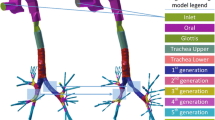Abstract
A mathematical model of aerosol deposition has been developed for drug delivery protocols and used successfully to simulate inhalation exposure tests with human subjects. Therefore, we have used the validated model to address the delivery of inhaled pharmaceuticals as a function of disease-induced changes in airway structure. Clinical data from the literature had suggested that progressive lung disease associated with cystic fibrosis (CF) could compromise the successful administration of pharmacologic drugs used in its treatment, hence it was studied. We described the lungs of patients inflicted with CF by different morphologies (representing the processes of airway obstruction, infection and inflammation) than healthy (control) subjects. Affected ventilatory parameters were also examined to demonstrate their effects upon drug disposition. Particle distributions were computed on a generation-by-generation basis. Deposition patterns were dramatically affected by CF-produced alterations in dimensions. The reduced airway caliber in CF enhanced the total dose delivered to the tracheobronchial compartment by 200-300% relative to controls. The spatial distributions of aerosols were completely different in CF patients, being selectively deposited within congested airways. In medical practice the model can be tailored to any specific airway disease. Regarding targeted delivery, the results have relevance to (1) site-specific acting pharmaceuticals in tracheobronchial airways and (2) drugs designed for systemic delivery via deposition in alveolated airways.
Similar content being viewed by others
REFERENCES
Martonen, T. B. (1993) Mathematical model for the selective deposition of inhaled pharmaceuticals, J. Pharm. Sci., 82: 1191–1199.
Martonen, T. B., and Katz, I. M. (1993) Deposition patterns of aerosolized drugs within human lungs: effects of ventilatory parameters, Pharm. Res., 10: 871–878.
Martonen, T. B., and Katz, I. M. (1993) Deposition patterns of polydisperse aerosols within human lungs, J. Aerosol Med., 6: 251–274.
Tomashefski, Jr., J. F., Abramowsky, C. R., and Dahms, B. B. (1993) The pathology of cystic fibrosis, In: Cystic Fibrosis, pp. 435–489 (Ed. Davis, P. B.), Marcel-Dekker, Inc., NY.
Davis, P. B. (1993) Pathophysiology of the lung disease in cystic fibrosis, In: Cystic Fibrosis, pp. 193–218 (Ed. Davis, P. B.), Marcel-Dekker, Inc., NY
Anderson, P. J., Blanchard, J. D., Brain, J. D., Feldman, H. A., McNamara, J. J., and Heyder, J. (1989) Effect of cystic fibrosis on inhaled aerosol boluses, Am. Rev. Respir. Dis., 140: 1317–1324.
Turpin, S. V., and Knowles, M. R. (1993) Treatment of pulmonary disease in patients with cystic fibrosis, In: Cystic Fibrosis, pp. 277–344 (Ed. Davis, P. B.), Marcel-Dekker, Inc., NY.
Kavanaugh, R. E., Unadkat, J. D., and Smith, A. L. (1993). Drug disposition in cystic fibrosis, In: Cystic Fibrosis, pp. 91–136 (Ed. Davis, P. B.), Marcel-Dekker, Inc., NY.
Agnew, J. E. (1984) Physical properties and mechanisms of deposition of aerosols, In: Aerosols and the Lung: Clinical and Experimental Aspects, pp. 49–70 (Eds., Clarke, S. W. and Pavia, D.), Butterworths, London.
Konstan, M. W., and Berger, M. (1993). Infection and inflammation of the lung in cystic fibrosis, In: Cystic Fibrosis, pp. 219–276 (Ed. Davis, P. B.), Marcel-Dekker, Inc., NY.
Davis, P. B. (Editor) (1993). Cystic Fibrosis, Marcel-Dekker, Inc., NY.
Gerken, T. A., and Gupta, R. (1993). Mucus in cystic fibrosis, In: Cystic Fibrosis, pp. 53–90 (Ed. Davis, P. B.), Marcel-Dekker, Inc., NY.
Jeffery, P. K., and Reid, L. M. (1977) The respiratory mucous membrane, In: Respiratory Defense Mechanisms, Part I, pp. 193–245 (Eds., Brain, J. D., Proctor, D. F., and Reid, L. M.), Marcel Dekker, Inc., NY.
Sleigh, M. A. (1977) The nature and action of respiratory tract cilia, In: Respiratory Defense Mechanisms, Part I, pp. 247–288 (Eds., Brain, J. D., Proctor, D. F., and Reid, L. M.), Marcel Dekker, Inc., NY.
Lopez-Vidriero, M. T., Das, I., and Reid, L. M. Airway secretion: source, biochemical and rheological properties, In: Respiratory Defense Mechanisms, Part I, pp. 289–356 (Eds., Brain, J. D., Proctor, D. F., and Reid, L. M.), Marcel Dekker, Inc., NY.
Keal, E. E. (1977) Physiological and pharmacological control of airways secretions, In: Respiratory Defense Mechanisms, Part I, pp. 357–401 (Eds., Brain, J. D., Proctor, D. F., and Reid, L. M.), Marcel Dekker, Inc., NY.
Covert, D. S., and Frank, N. R. (1980) Atmospheric particles: behavior and functional aspects, In: Physiology and Pharmacology of the Airways, pp. 259–295 (Ed., Nadel, J. A.), Marcel-Dekker, Inc., NY.
King, M., Chang, H. K., and Weber, M. E. (1982) Resistance of mucus-lined tubes to steady and oscillatory airflow, J. Appl. Physiol., 52: 1172–1176.
Clarke, S. E., Jones, J. G., and Oliver, D. R. (1970) Resistance to two-phase gas-liquid flow in airways, J. Appl. Physiol., 29; 464–471.
Clarke, S. W. (1973) The role of two-phase flow in bronchial clearance, Bull. Physiol-Pathol. Respir., 9: 359–372.
Weibel, E. R. (1963) Morphometry of the Human Lung, Springer-Verlag, Berlin.
Martonen, T. B. (1983) On the fate of inhaled particles in the human: a comparison of experimental data with theoretical computations based on a symmetric and asymmetric lung, Bull. Math. Biol. 45: 409–424.
Martonen, T. B. (1982) Analytical model of hygroscopic particle behavior in human airways, Bull. Math. Biol. 44: 425–442.
Stahlhofen, W., Rudolf, G., and James, A. C. (1989) Intercomparison of experimental regional aerosol deposition data, J. Aerosol Med., 2: 285–308.
Miller, F. J., Martonen, T. B., Menache, M. G., Graham, R. C., Spektor, D. M., and Lippmann, M. (1988) Influence of breathing mode and activity level on the regional deposition of inhaled particles and implications for regulatory standards, In: Inhaled Particles VI, pp. 3–10 (Eds., Dodgson, J., McCallum, R. I., Bailey, M. R., and Fisher, D. R.), Pergamon Press, Oxford.
Martonen, T. B. and Zhang, Z. (1992) Comments on recent data for particle deposition in human nasal passages, J. Aerosol Sci., 23: 667–674.
Martonen, T. B., Graham, R. C., and Hofmann, W. (1989) Human subject age and activity level: factors addressed in a biomathematical deposition program for extrapolation modeling, Health Phys., 57: 49–59.
Martonen, T. B. (1991) Aerosol therapy implications of particle deposition patterns in simulated human airways, J. Aerosol Med., 4: 25–40.
Author information
Authors and Affiliations
Rights and permissions
About this article
Cite this article
Martonen, T., Katz, I. & Cress, W. Aerosol Deposition as a Function of Airway Disease: Cystic Fibrosis. Pharm Res 12, 96–102 (1995). https://doi.org/10.1023/A:1016294805680
Issue Date:
DOI: https://doi.org/10.1023/A:1016294805680




